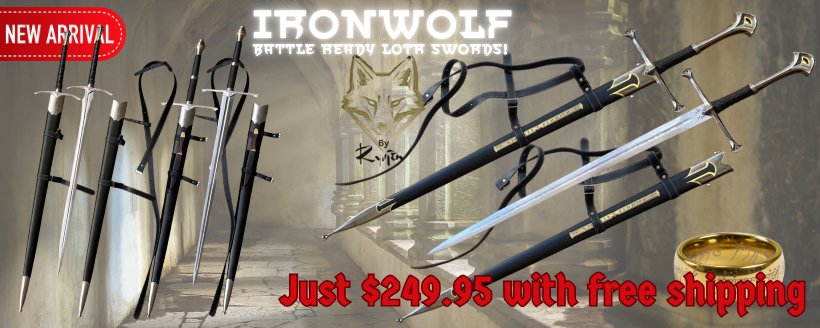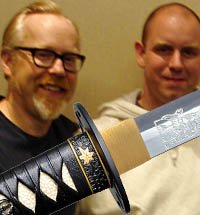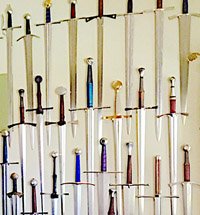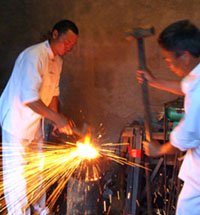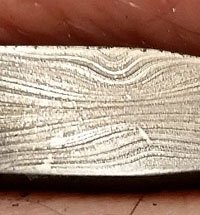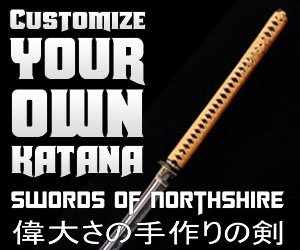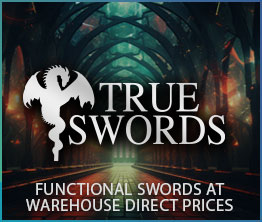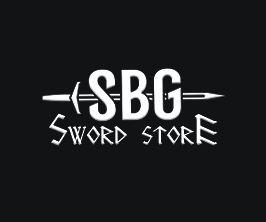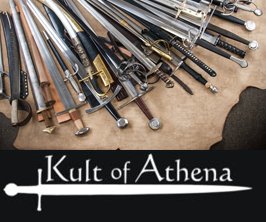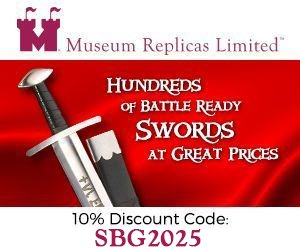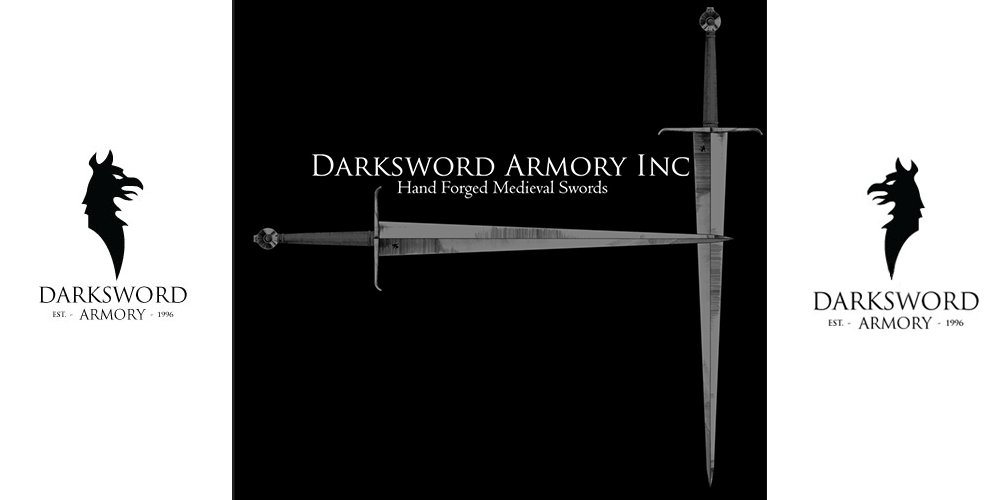Kiangxi Sword Review
The Kianxi Sword by Ryujin Swords (also known as the 'horsebane' due to its historical usage on the battlefield to chop into a horses legs at close range and effectively hamstring Cavalry) is presented in our store as a cheap, entry level sword with a half decent 65mn spring steel blade and basic fittings.
In this hands on review by one of our SBG members, we take a closer look at this sword to see exactly what you should expect and decide for yourself if an entry level replica for $160 is good enough, and if you really need to spend more or not.
Ryujin Kiangxi Sword (Horsebane)
Review by SBG member Alientude

Manufacturers looking to create budget reproductions of historical swords are in something of a tricky place. Accuracy comes at a price. It's not terribly difficult or costly to get a sword close to the original; it's the little details that start adding to the cost. In my opinion, the goal of a budget reproduction is to get the overall look, feel, and profile of the sword close enough to be able to say, "yes, this sword is meant to be a reproduction of X sword," while still ensuring the reproduction is fully usable. I think this sword manages to meet those criteria.
Full Disclosure
Everything in this review is nothing more than my novice opinion on the
specific sword I received. I am a sword-collecting enthusiast, but I am
in no way a historian, sword expert, or martial artist. Further, my
knowledge of swords mainly focuses on medieval European swords, so this
sword is very much outside my wheelhouse. I'll try to be as accurate as I
can, but I'll likely make some mistakes, and I apologize for those in
advance.
I bought this sword from the SBG store for $174.99 with my own money.
Historical Overview
This sword is based on Emperor Kangxi's (1654 - 1722) personal 2-handed
saber. The original is preserved, but I'm not clear where. The main
reference I've found while doing this review can be found here
(it's the 7th sword on this list). I'm not going to post the pictures
from there in this thread, as I don't feel comfortable doing so as they
might be copyrighted. Please visit the page to reference them. The title
of the page indicates the swords are part of collections in either the
Musee De Armee in Paris, or the Forbidden City Palace Museum in Beijing.
The listing for this specific sword mentions it being preserved in a
Buddhist temple. I tried looking through the websites for both museums
mentioned, but wasn't able to find this sword (possibly because I don't
read French, Mandarin, or Cantonese).
The original sword was
likely a type used by small tribes in the Yunnan Province, and it is
speculated that it was gifted to Emperor Kangxi by one of these tribes.
It's also possible it was a recreation by an Imperial workshop.
Let's
look at the first goal I stated for a budget reproduction – get the
overall look, feel, and profile of the sword close enough to the
original. I think this is a success. The original sword is a very
striking piece, and quite unusual. Looking at the reproduction, it's
immediately obvious that it's designed to be either a reproduction or
inspired by the original. As for functionality, that will be covered
later in the review. Differences between the original and the
reproduction will be covered in the individual blade components below.
Specifications
- Blade length: 21 1/2" (54.6 cm)
- Blade width: 1 9/16" (4 cm) near the guard and near the tip before angled section
- Point of Balance: exactly on the Hūshǒu (guard)
- Cáo (fuller) length: 14 1/8" (35.9 cm)
- Cáo width: 5/16" (7.9 mm)
- Cáo depth: 0.054" (1.4 mm)
- Distal taper: 0.241" (6.1 mm) near hūshǒu (guard), 0.220" (5.6 mm) halfway up blade, 0.206" (5.2 mm) near place where blade begins angled section, 0.0355" (0.9 mm) at tip.
- Hūshǒu (guard) width: 0.3065" (7.8 mm)
- Hūshǒu diameter: 3.166" (8 cm)
- Bǎ (grip) length: 14 1/4" (36.2 cm)
- Bǎ diameter: 1.2635" (3.2 cm)
- Dǐngshù (pommel/butt cap) length: 1 1/4" (3.2 cm)
- Overall length: 37 1/2" (95.3 cm)
- Weight (sword only): 4 lbs (1.8 kg)
- Weight (sword + scabbard): 5.8 lbs (2.63 kg)
Components
Rèn (blade)
65MN Spring Steel
The gently curved rèn is thick at
the bèi (spine) and feels extremely stout. The profile of the blade is
smooth – it evenly narrows from the bèi to the rèn (edge), creating a
cross section that should make for a very effective cutter. It's quite a
short blade at only 21 1/2". The cáo (fuller) starts a few inches away
from the hūshǒu (guard), and ends a few inches from the part of the
blade where the sharp angle begins.
The original sword appears to have a dragon-themed tūnkǒu (collar on blade), which this sword is missing completely. I'm rather disappointed that it's not there, as the majority of Chinese-styled daos and sabers on the market generally have them. The original sword also appears to have some engraving or plating on the blade – it might be dragon-themed as well, but the photo I have is too low quality to really tell. This is also missing on the reproduction.


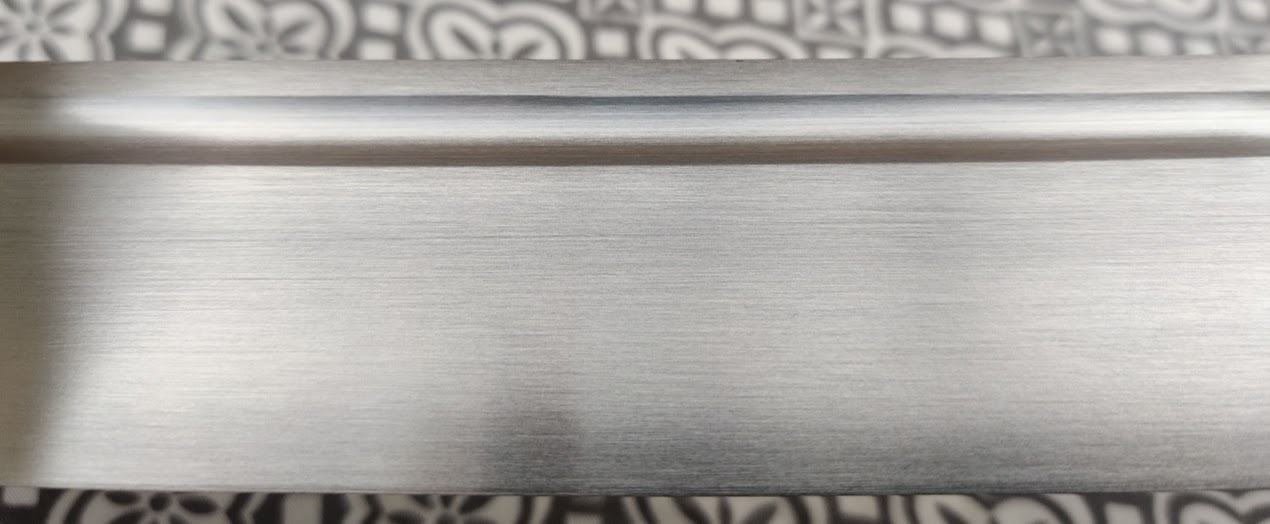
Hūshǒu (guard)
Cast zinc aluminum
The hūshǒu has a dragon-themed pattern that
matches the theming on the rest of this sword. The pictures I can find
of the original do not show any details on the hūshǒu, so I can't
comment on how faithful to the original it is. To my eye, it looks like
the original's hūshǒu is a little bit smaller than the reproduction's.
The casting looks pretty sharp to me, with a good amount of detail. The
fit of the hūshǒu to the rèn (blade) is decent, although there's
definitely some gaps.
The biggest flaw in the hūshǒu is what on a
katana would be called a seppa. On this sword it's either a different
material than the zinc aluminum, or has a different finish, and while
its shape is the same as the design on the hūshǒu that it's met to sit
on, it's offset. Pictures below will do a much better job of explaining
this.

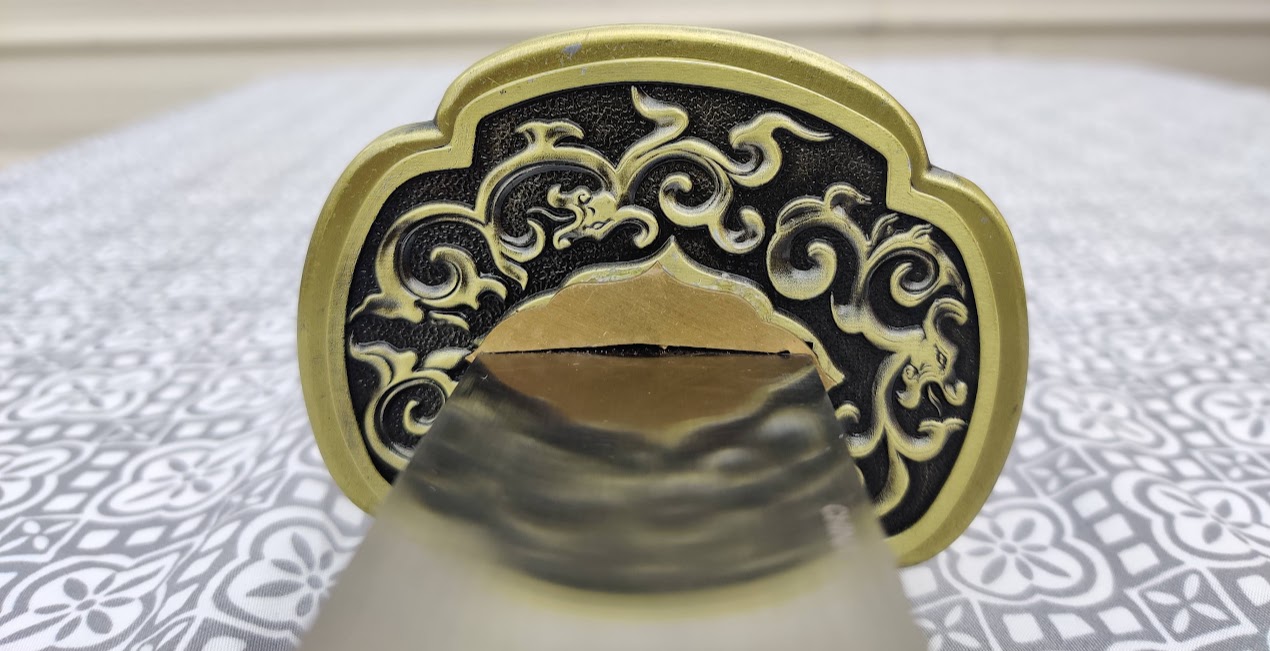
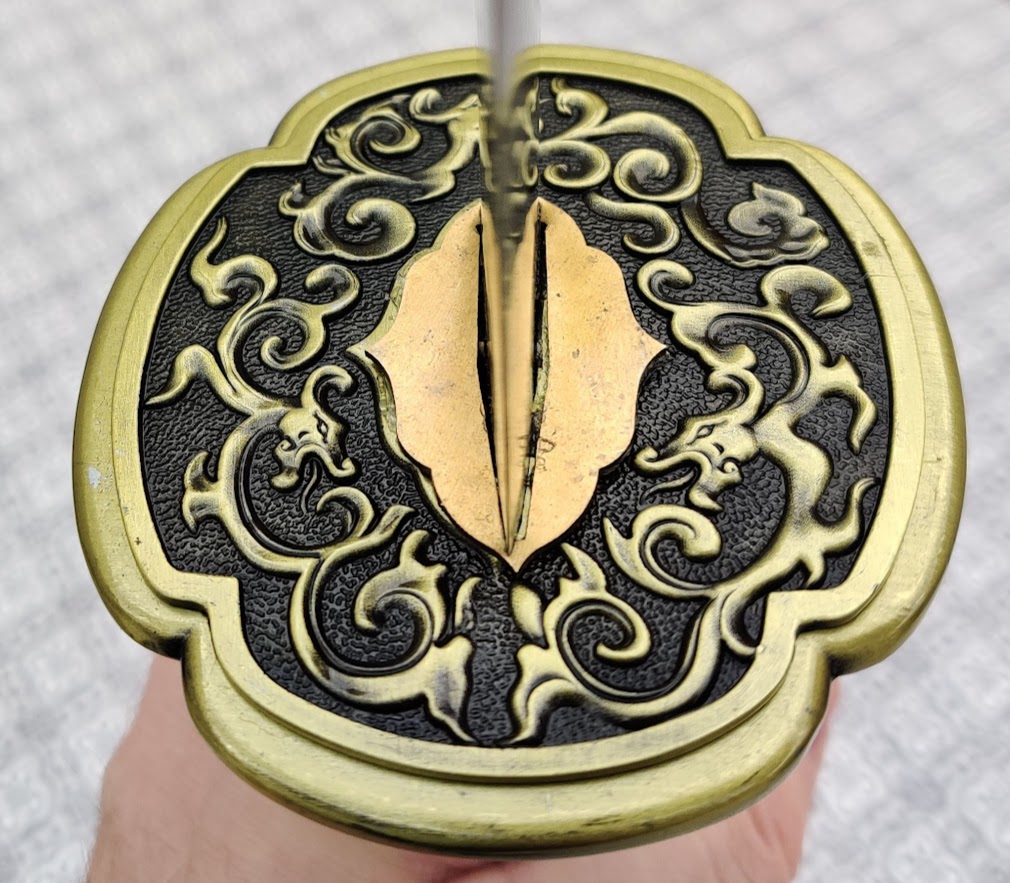
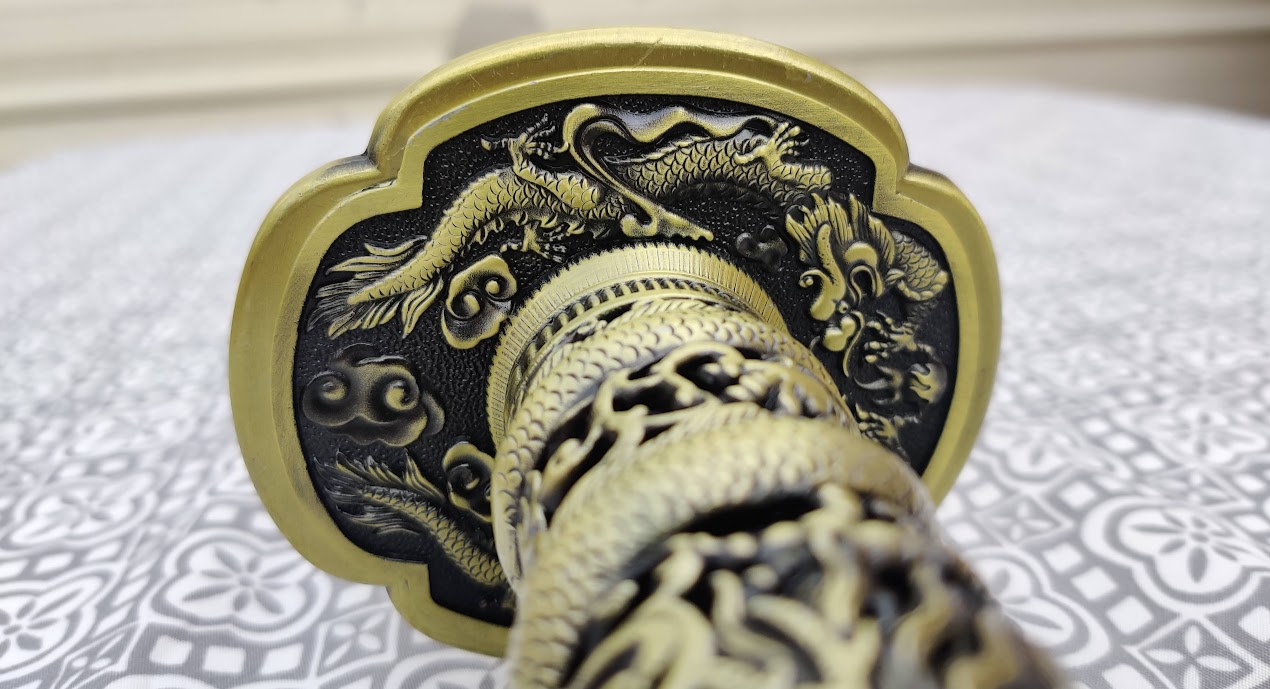
Bǎ (grip)
Cast zinc aluminum
The bǎ of the original sword looks like it's of
multi-part construction, with parts that are probably either bronze or
brass, and other parts that I'm guessing are steel. The reproduction is
all one piece of cast zinc aluminum made to look like brass. The designs
on the bǎ are considerably different from the original sword.
On
the original sword, there is what on a katana would be called a fuchi
between the bǎ and hūshǒu. This piece is completely missing from the
reproduction. The grip is circular, which definitely causes me some edge
alignment difficulties. It looks like this is faithful to the original,
however. There are 4 small globes on the back side of the 4 central
rings in the sword - they might be designed to help with edge alignment.
I found they didn't help, however, as my hands rested naturally closer
to the hūshǒu (guard) and dǐngshù (pommel/butt cap).
The casting
is mostly clean and detailed, although there is a part in the middle of
the bǎ where there's a definite line that looks like it was the seam in
the mold.
I do not know how the bǎ is assembled, but I'm guessing
it's simply epoxied to the shènwēi (tang). There does not appear to be
any mechanical connections.

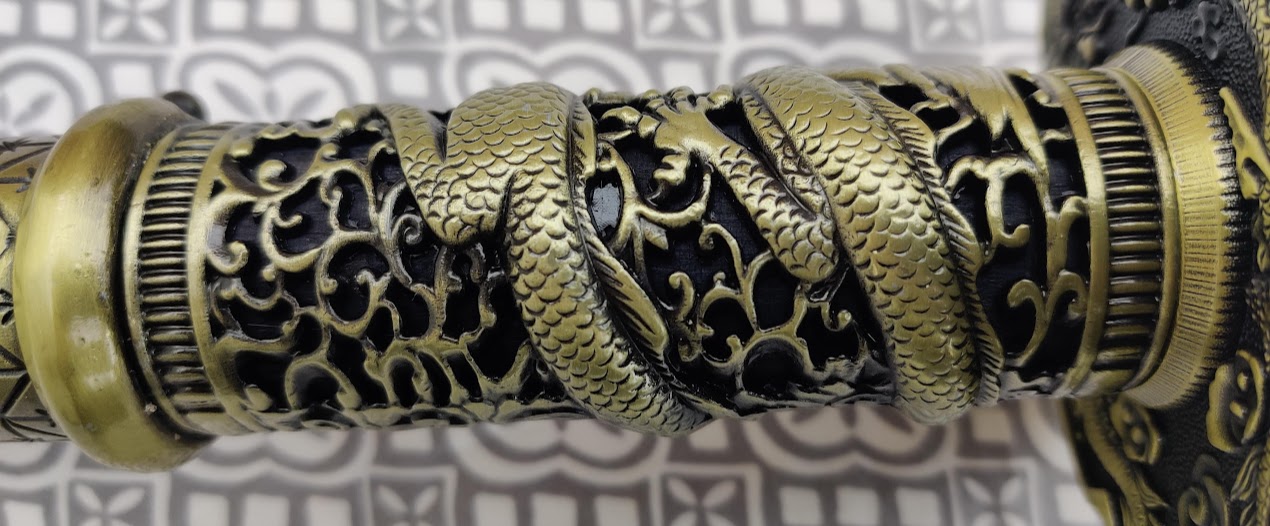
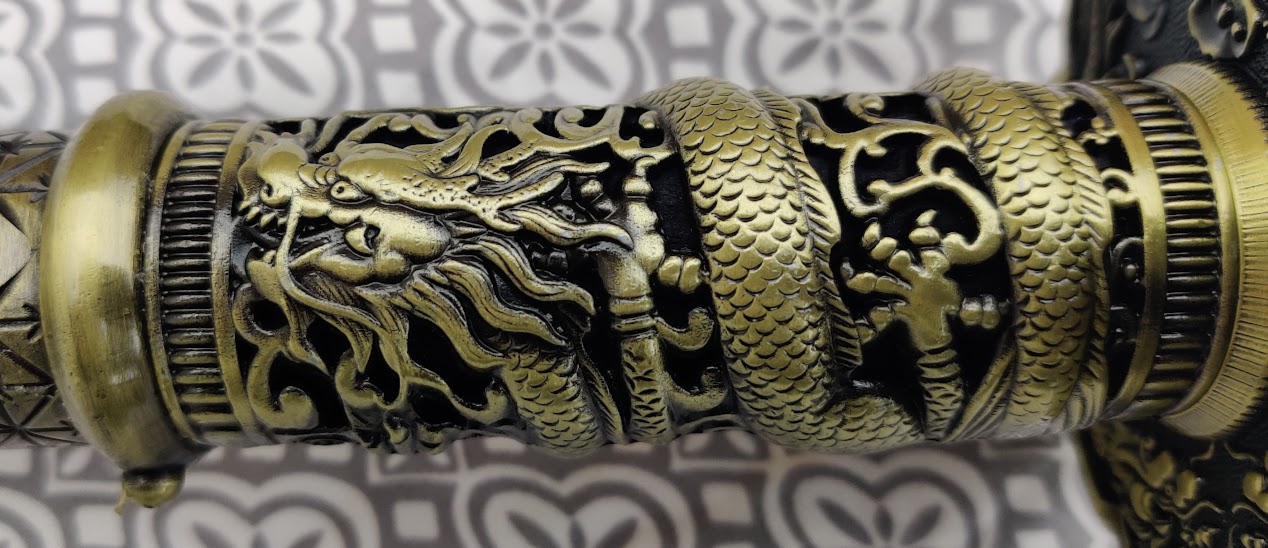
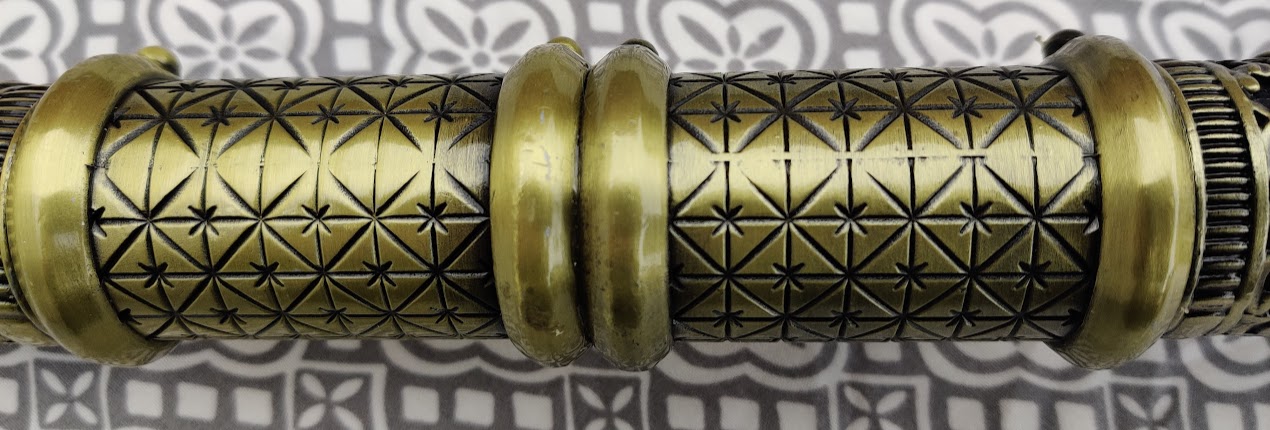


Dǐngshù (pommel/butt cap)
Cast zinc aluminum
The original sword does not have a dǐngshù – it has a ring instead. The reproduction has what I think is supposed to be a lion figure. The casting on this piece is worse than the rest of the sword, especially the front of the figure, where it's not nearly as detailed.
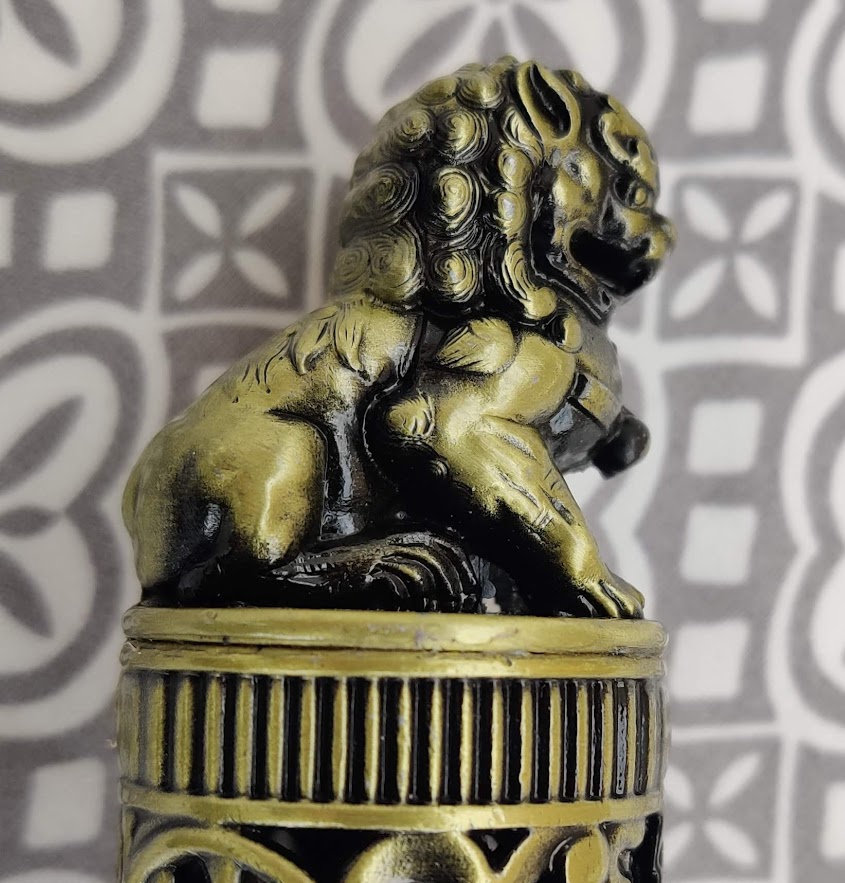
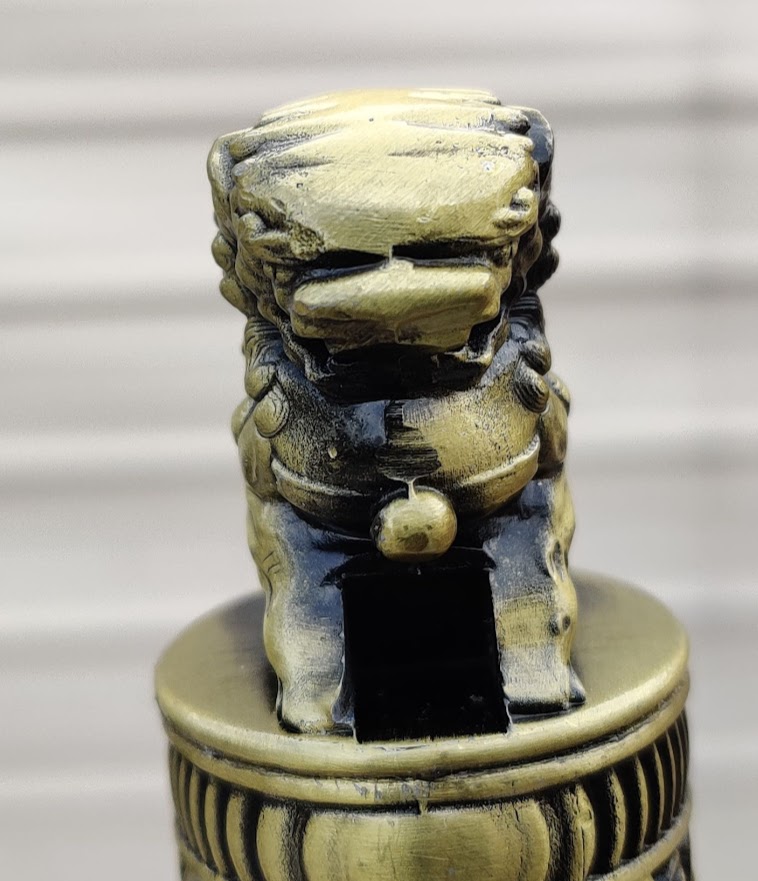
Qiào (scabbard)
Wood core, faux-leather wrap, cast zinc aluminum fittings
Once again,
the design of the castings are different from the original. The
castings are again pretty sharp and detailed. The zhōngshù (suspension
bands wrapped around the qiào) are considerably different – they're
thicker and they don't have what looks like loose rings on the original.
The
faux-leather wrap feels nice in the hand, although it bunches up a bit
near the dǐshù (mouthpiece/collar). It's hard to tell with the original,
but it looks like there was a good amount of detail work on the leather
which is missing on the reproduction, instead going for a basic
texture.
The fit of the qiào to the rèn (blade) is lousy. There's
no retention whatsoever, and the sword rattles near the fēng (tip).
There's also a glob of epoxy on the outside of the dǐshù.

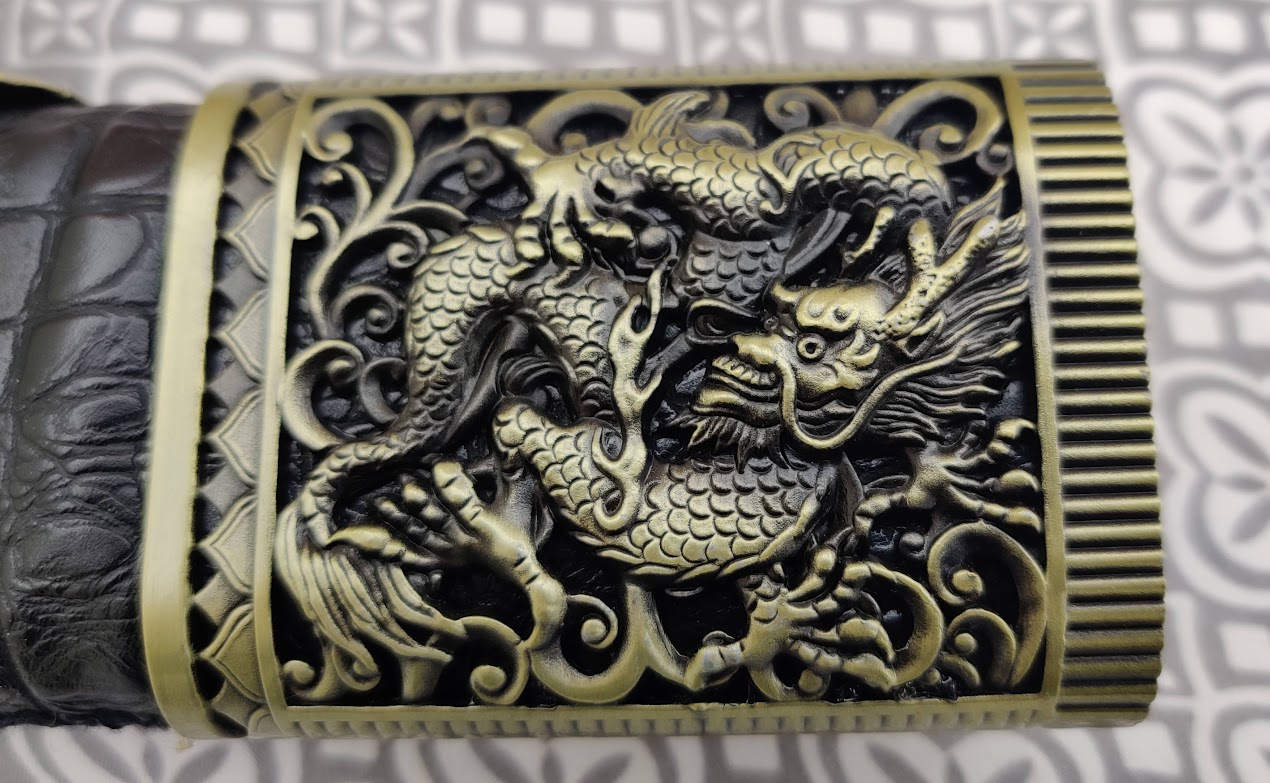
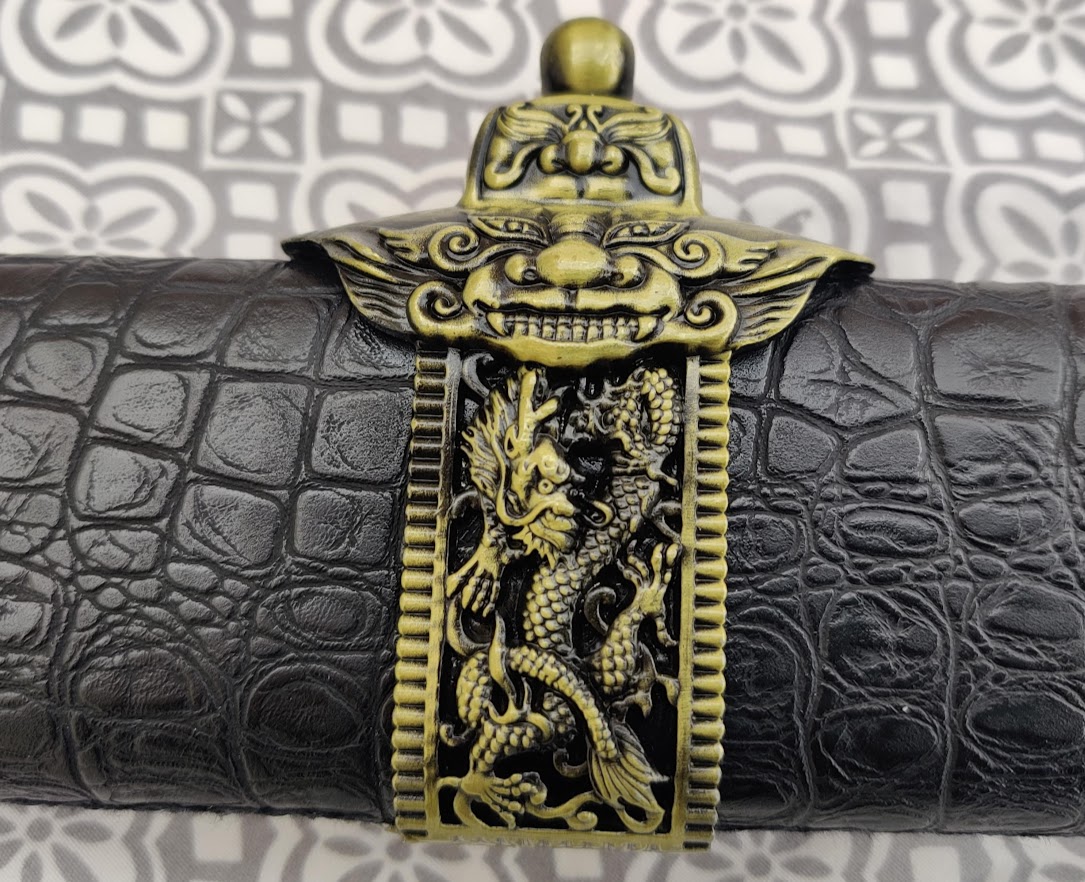
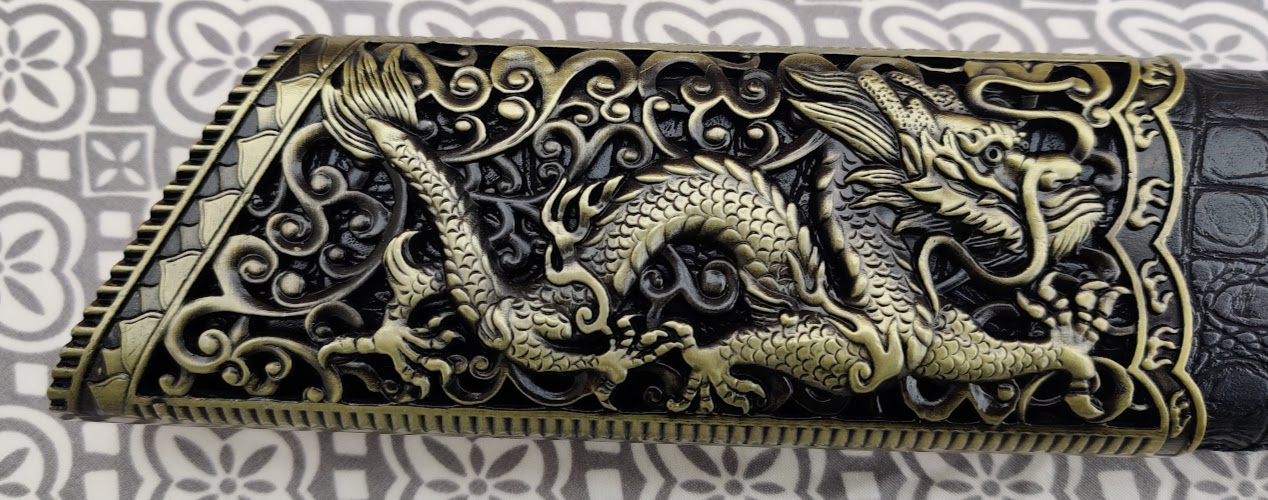

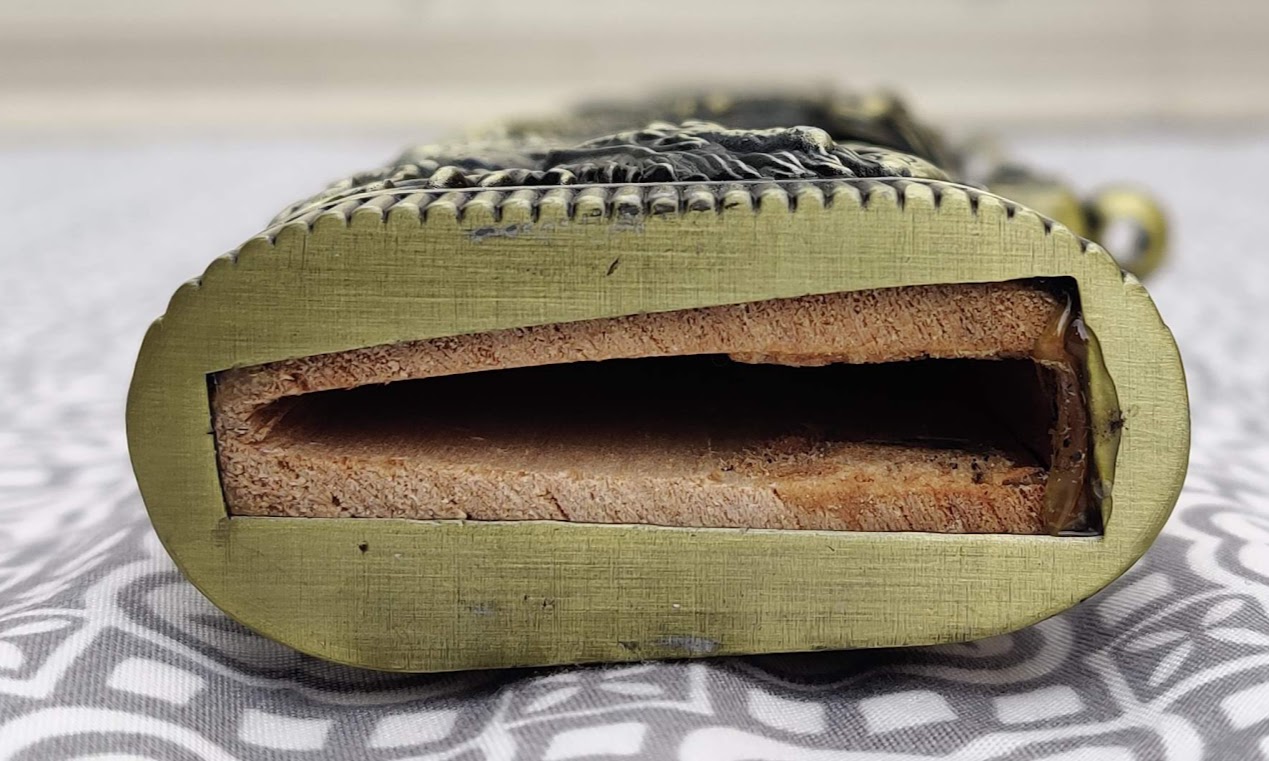
Handling
This sword handles oddly to me. Its point of balance is exactly on the
hūshǒu (guard). That brings to mind Renaissance-era rapiers or side
swords, with their focus on thrusts, not single-edged cutters like a
two-handed saber. It makes the sword light and easy to use, but will
definitely reduce the cutting power.
As I mentioned in the bǎ
(grip) section, the circular bǎ gave me problems with edge alignment. I
can't criticize this, since it's designed as a reproduction of a
historical sword, and the original looks like it has a circular bǎ as
well.
Test Cutting
Paper Test
Swords don't necessarily need to be able to cut paper.
It's not the purpose for which they're designed, but I find it to be a
good way to measure the evenness of the sharpening – as the blade draws
through the paper, if there's a duller spot or burr, it will often tear
the paper at that point.
This sword cuts through paper with ease, not tearing at all. It's very sharp.
Water Bottles
I'm
a novice at cutting. My form and consistency is not good at this point.
Most of the time when I cut with this sword, I basically blew through
the water bottles, cutting them in half but also flinging both parts
away. This is my fault, not the sword's. I did manage a few cuts that
were clean.
Thicker plastic bottle
I had a coffee creamer
plastic bottle that I filled with water and cut. Thanks to the larger
size and weight of the bottle, I was able to get a very nice, clean cut
that left the bottom of the bottle in place. Progress!
Thrusting
My
thrusting tests with this sword were surprising. I didn't expect the
geometry of the fēng (point) to penetrate all that well, but it thrusts
very easily and cleanly. I tested against small water bottles and the
bottles didn't really move when I thrust through them.
All told, this is a very sharp sword and cuts well.
Conclusion
This is an interesting reproduction of the original sword. Ryujin went
with their own theme on the fittings, and they all match – it's dragons
throughout, except on the dǐngshù (pommel/butt cap), which is a lion. I
think. I could be a dragon if I squint at it. There's obviously more
details on the original, and the more you compare the swords, the more
differences you spot. However, it's important to remember that this is a
budget sword – it's less than $200. For that price, you get a highly
functional sword that definitely resembles the original. That's pretty
much exactly what I want out of a budget reproduction.
PROS
- Beautiful sword
- Highly functional – sharp and fun to use
- Point of balance being exactly on the hūshǒu (guard) makes the sword extremely comfortable to swing
CONS
- Circular bǎ (grip) can cause edge alignment difficulty (true to the original)
- Scabbard fit is not good
- Point of balance being exactly on the hūshǒu (guard) for a sword that profiles as a cutter is an odd position – normally you'd want it to be forward of the guard to add power to the cut.
The Bottom Line
I think this is a great budget reproduction sword. Though it's not nearly 100% accurate to the original, I'd say it's around 85-90% faithful, which is really all you can expect for a budget sword. It's a fun sword to cut with, and it looks great on display. What more can you ask for at this price point?
The full gallery of pictures I took of this sword can be found here.
WHERE TO BUY
The Horsebane Kiangxi Sword is currently on sale for $179.99 right here at the SBG Sword Store. We also stock other similar budget Chinese blades from Ryujin in the store HERE - can't expect too much for under $200, but most of these are pretty poplular and well received, so worth a look.
I hope this review of the budget Kiangxi Sword was helpful. To return to Chinese Swords from the Ryujin Kiangxi Sword Review, click here

Buying Swords Online Can Be DANGEROUS!
Find the Best Swords in the:
Popular & Recommended ARTICLES
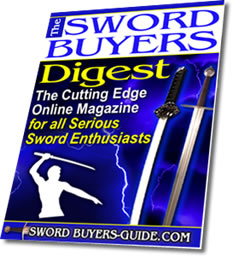
The ONLY true free online magazine for sword enthusiasts. Delivered once a month on the 1st day of the month, no filler and no BS, just the latest sword news & info delivered straight to your inbox.

